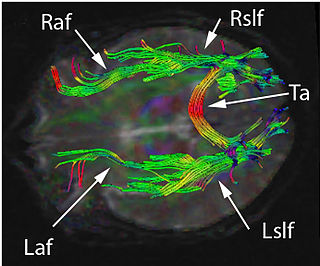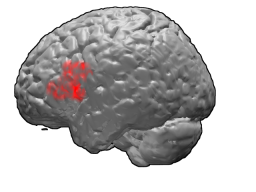
Wernicke's aphasia, also known as receptive aphasia, sensory aphasia or posterior aphasia, is a type of aphasia in which individuals have difficulty understanding written and spoken language. Patients with Wernicke's aphasia demonstrate fluent speech, which is characterized by typical speech rate, intact syntactic abilities and effortless speech output. Writing often reflects speech in that it tends to lack content or meaning. In most cases, motor deficits do not occur in individuals with Wernicke's aphasia. Therefore, they may produce a large amount of speech without much meaning. Individuals with Wernicke's aphasia are typically unaware of their errors in speech and do not realize their speech may lack meaning. They typically remain unaware of even their most profound language deficits.

Broca's area, or the Broca area, is a region in the frontal lobe of the dominant hemisphere, usually the left, of the brain with functions linked to speech production.

Anomic aphasia is a mild, fluent type of aphasia where individuals have word retrieval failures and cannot express the words they want to say. By contrast, anomia is a deficit of expressive language, and a symptom of all forms of aphasia, but patients whose primary deficit is word retrieval are diagnosed with anomic aphasia. Individuals with aphasia who display anomia can often describe an object in detail and maybe even use hand gestures to demonstrate how the object is used, but cannot find the appropriate word to name the object. Patients with anomic aphasia have relatively preserved speech fluency, repetition, comprehension, and grammatical speech.

Brodmann area 45 (BA45), is part of the frontal cortex in the human brain. It is situated on the lateral surface, inferior to BA9 and adjacent to BA46.

Wernicke's area, also called Wernicke's speech area, is one of the two parts of the cerebral cortex that are linked to speech, the other being Broca's area. It is involved in the comprehension of written and spoken language, in contrast to Broca's area, which is primarily involved in the production of language. It is traditionally thought to reside in Brodmann area 22, which is located in the superior temporal gyrus in the dominant cerebral hemisphere, which is the left hemisphere in about 95% of right-handed individuals and 70% of left-handed individuals.
The Levels of Processing model, created by Fergus I. M. Craik and Robert S. Lockhart in 1972, describes memory recall of stimuli as a function of the depth of mental processing. Deeper levels of analysis produce more elaborate, longer-lasting, and stronger memory traces than shallow levels of analysis. Depth of processing falls on a shallow to deep continuum. Shallow processing leads to a fragile memory trace that is susceptible to rapid decay. Conversely, deep processing results in a more durable memory trace. There are three levels of processing in this model. Structural processing, or visual, is when we remember only the physical quality of the word E.g how the word is spelled and how letters look. Phonemic processing includes remembering the word by the way it sounds. E.G the word tall rhymes with fall. Lastly, we have semantic processing in which we encode the meaning of the word with another word that is similar of has similar meaning. Once the word is perceived, the brain allows for a deeper processing.
The lexical decision task (LDT) is a procedure used in many psychology and psycholinguistics experiments. The basic procedure involves measuring how quickly people classify stimuli as words or nonwords.

The lateralization of brain function is the tendency for some neural functions or cognitive processes to be specialized to one side of the brain or the other. The median longitudinal fissure separates the human brain into two distinct cerebral hemispheres, connected by the corpus callosum. Although the macrostructure of the two hemispheres appears to be almost identical, different composition of neuronal networks allows for specialized function that is different in each hemisphere.

The lingual gyrus, also known as the medialoccipitotemporal gyrus, is a brain structure that is linked to processing vision, especially related to letters. It is thought to also play a role in analysis of logical conditions and encoding visual memories. It is named after its shape, which is somewhat similar to a tongue. Contrary to the name, the region has little to do with speech.
Paraphasia is a type of language output error commonly associated with aphasia, and characterized by the production of unintended syllables, words, or phrases during the effort to speak. Paraphasic errors are most common in patients with fluent forms of aphasia, and come in three forms: phonemic or literal, neologistic, and verbal. Paraphasias can affect metrical information, segmental information, number of syllables, or both. Some paraphasias preserve the meter without segmentation, and some do the opposite. However, most paraphasias affect both partially.
David Swinney was a prominent psycholinguist. His research on language comprehension contributed to methodological advances in his field.
Deep dyslexia is a form of dyslexia that disrupts reading processes. Deep dyslexia may occur as a result of a head injury, stroke, disease, or operation. This injury results in the occurrence of semantic errors during reading and the impairment of nonword reading.
Convergent thinking is a term coined by Joy Paul Guilford as the opposite of divergent thinking. It generally means the ability to give the "correct" answer to standard questions that do not require significant creativity, for instance in most tasks in school and on standardized multiple-choice tests for intelligence.
Priming is the idea that exposure to one stimulus may influence a response to a subsequent stimulus, without conscious guidance or intention. The priming effect refers to the positive or negative effect of a rapidly presented stimulus on the processing of a second stimulus that appears shortly after. Generally speaking, the generation of priming effect depends on the existence of some positive or negative relationship between priming and target stimuli. For example, the word nurse might be recognized more quickly following the word doctor than following the word bread. Priming can be perceptual, associative, repetitive, positive, negative, affective, semantic, or conceptual. Priming effects involve word recognition, semantic processing, attention, unconscious processing, and many other issues, and are related to differences in various writing systems. Research, however, has yet to firmly establish the duration of priming effects, yet their onset can be almost instantaneous.

Right hemisphere brain damage (RHD) is the result of injury to the right cerebral hemisphere. The right hemisphere of the brain coordinates tasks for functional communication, which include problem solving, memory, and reasoning. Deficits caused by right hemisphere brain damage vary depending on the location of the damage.
The mental lexicon is defined as a mental dictionary that contains information regarding the word store of a language user, such as their meanings, pronunciations, and syntactic characteristics. The mental lexicon is used in linguistics and psycholinguistics to refer to individual speakers' lexical, or word, representations. However, there is some disagreement as to the utility of the mental lexicon as a scientific construct.
Linguistic prediction is a phenomenon in psycholinguistics occurring whenever information about a word or other linguistic unit is activated before that unit is actually encountered. Evidence from eyetracking, event-related potentials, and other experimental methods indicates that in addition to integrating each subsequent word into the context formed by previously encountered words, language users may, under certain conditions, try to predict upcoming words. In particular, prediction seems to occur regularly when the context of a sentence greatly limits the possible words that have not yet been revealed. For instance, a person listening to a sentence like, "In the summer it is hot, and in the winter it is..." would be highly likely to predict the sentence completion "cold" in advance of actually hearing it. A form of prediction is also thought to occur in some types of lexical priming, a phenomenon whereby a word becomes easier to process if it is preceded by a related word. Linguistic prediction is an active area of research in psycholinguistics and cognitive neuroscience.
Embodied cognition occurs when an organism's sensorimotor capacities, body and environment play an important role in thinking. The way in which a person's body and their surroundings interacts also allows for specific brain functions to develop and in the future to be able to act. This means that not only does the mind influence the body's movements, but the body also influences the abilities of the mind, also termed the bi-directional hypothesis. There are three generalizations that are assumed to be true relating to embodied cognition. A person's motor system is activated when (1) they observe manipulable objects, (2) process action verbs, and (3) observe another individual's movements.
Comprehension of idioms is the act of processing and understanding idioms. Idioms are a common type of figure of speech. Based on common linguistic definitions, an idiom is a combination of words that contains a meaning that cannot be understood based on the literal definition of the individual words. An example of an idiom is hit the sack, which means to go to bed. It can be used in a sentence like the following: I'm beat; I'm gonna hit the sack.

Verbal intelligence is the ability to understand and reason using concepts framed in words. More broadly, it is linked to problem solving, abstract reasoning, and working memory. Verbal intelligence is one of the most g-loaded abilities.








